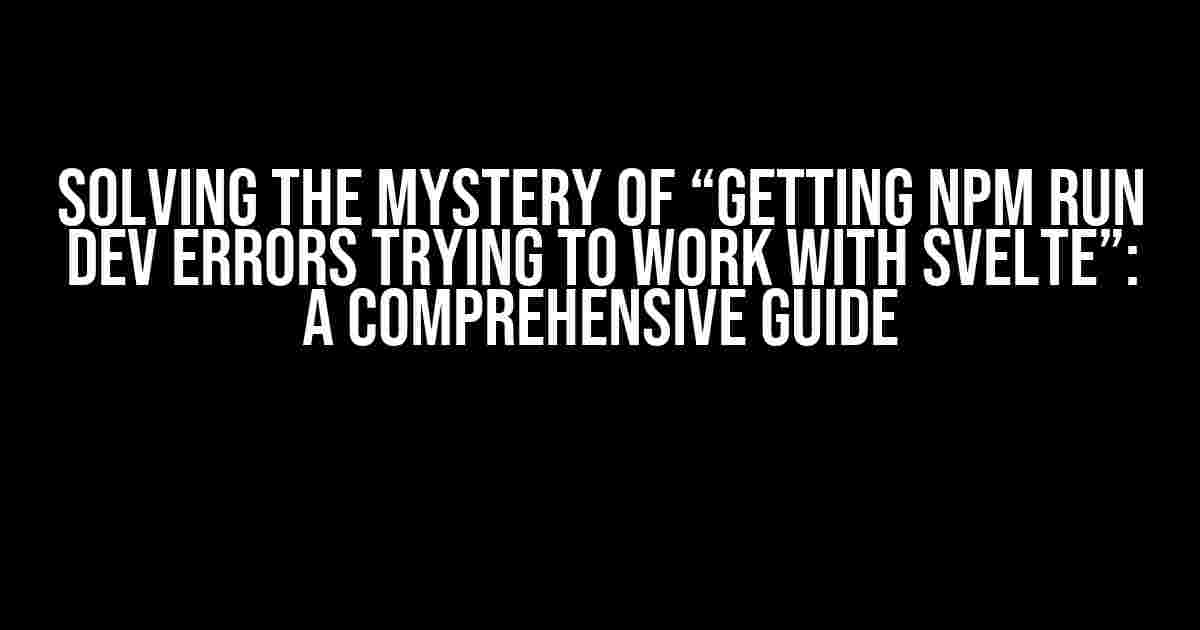Are you tired of banging your head against the wall, trying to figure out why your Svelte project won’t run with npm? Well, you’re in luck! This article will be your trusty sidekick, guiding you through the process of identifying and fixing those pesky “npm run dev” errors that have been plaguing you.
What is npm run dev, and why is it important?
Before we dive into the troubleshooting process, let’s quickly cover the basics. “npm run dev” is a command used to start a development server for your Svelte application. It’s an essential part of the development process, as it allows you to see your changes in real-time, without having to rebuild your project every time you make a change.
When you run “npm run dev”, Svelte creates a development server that listens to changes in your code and updates your application accordingly. This means you can focus on writing code, while Svelte takes care of the heavy lifting.
So, why does “npm run dev” sometimes fail to work its magic? Here are some common culprits to look out for:
- Outdated dependencies: Old dependencies can cause compatibility issues, leading to errors.
- Incorrect configuration: Misconfigured files, such as rollup.config.js or svelte.config.js, can prevent the development server from running.
- Code errors: Syntax errors or typos in your code can prevent the development server from starting.
- Node.js version issues: Using an incompatible version of Node.js can cause problems.
- File system issues: Problems with your file system, such as corrupted files or permissions issues, can prevent the development server from running.
<
Step-by-Step Troubleshooting Guide
Now that we’ve covered the common causes of “npm run dev” errors, let’s go through a step-by-step guide to troubleshoot and fix these issues.
Step 1: Check for Outdated Dependencies
The first step is to check if your dependencies are up-to-date. You can do this by running the following command in your terminal:
npm outdatedThis command will show you a list of outdated dependencies. Update them using:
npm install @latest Replace `
Step 2: Check Your Configuration Files
Next, let’s take a look at your configuration files. Make sure they’re correctly configured and formatted.
Open your `rollup.config.js` file and check for any syntax errors or typos. Make sure it’s correctly configured for your Svelte project.
If you’re using a `svelte.config.js` file, check it for any errors or misconfigurations as well.
Step 3: Check for Code Errors
Syntax errors or typos in your code can prevent the development server from running. Check your code for any errors or warnings.
Use a code editor or IDE with syntax highlighting and code completion to help you identify any errors.
Step 4: Check Your Node.js Version
Make sure you’re using a compatible version of Node.js. You can check your Node.js version by running:
node -vCompare your version to the recommended version for your Svelte project. If you’re using an outdated version, update Node.js to the latest version.
Step 5: Check Your File System
Finally, let’s check your file system for any issues. Make sure your project files are not corrupted, and you have the correct permissions to access them.
Try deleting your `node_modules` folder and running `npm install` again to reinstall your dependencies.
Common Error Messages and Solutions
Here are some common error messages you might encounter, along with their solutions:
| Error Message | Solution |
|---|---|
| “Cannot find module ‘svelte'” | Run `npm install svelte` to reinstall Svelte. |
| “Error: Unable to find rollup.config.js” | Create a `rollup.config.js` file in the root of your project, or update the path in your `package.json` file. |
| “Error: Cannot read property ‘length’ of undefined” | Check your code for syntax errors or typos. Ensure that you’re not trying to access an undefined property. |
| “Error: Node.js version is not supported” | Update Node.js to a compatible version. Check the recommended version for your Svelte project. |
Conclusion
Getting “npm run dev” errors can be frustrating, but with this comprehensive guide, you should be able to identify and fix the issue. Remember to check for outdated dependencies, incorrect configuration, code errors, Node.js version issues, and file system problems.
By following these steps and troubleshooting tips, you’ll be back to developing your Svelte application in no time. Happy coding!
Still stuck? Try searching for more specific error messages or seeking help from the Svelte community. Good luck!
Frequently Asked Question
Stuck with those pesky npm run dev errors while trying to work with Svelte? Don’t worry, we’ve got you covered!
Why do I get a “ReferenceError: document is not defined” error when running npm run dev?
This error occurs because Svelte tries to access the document object which is only available in the browser, not in the Node.js environment. To fix this, you need to configure Rollup (Svelte’s bundler) to only include browser-specific code in the bundle. You can do this by adding `output.inlineDynamicImports: true` to your `rollup.config.js` file.
How do I fix the “Error: Unable to resolve module specifier” error?
This error usually occurs when there’s an issue with the imports in your Svelte files. Make sure that the file path and the component name are correct, and that the file is in the correct location. Also, check if you’ve used the correct casing for the component name (Svelte is case-sensitive!). If you’re still stuck, try deleting the `node_modules` folder and running `npm install` again.
Why do I get a “TypeError: Failed to fetch” error when trying to fetch data from an API?
This error usually occurs when the API request is being blocked by CORS (Cross-Origin Resource Sharing) policy. To fix this, you can either configure your API to allow CORS requests or use a proxy server to bypass the CORS restriction. You can also use the `sveltekit-adapter` to handle API requests in a more robust way.
What’s the deal with the “Duplicate module” error?
This error occurs when Svelte tries to import a module that’s already been imported elsewhere. To fix this, make sure that you’re not importing the same module multiple times in your code. Also, check if you’ve used the correct import statement and that the module is correctly installed in your project.
How do I fix the “TypeError: Cannot read property ‘ xxx’ of undefined” error?
This error usually occurs when you’re trying to access a property of an undefined object. To fix this, make sure that the object is correctly defined and initialized before trying to access its properties. Also, check if you’ve used the correct syntax and that there are no typos in your code.



